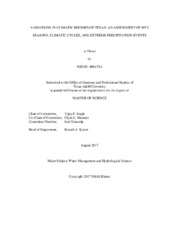| dc.description.abstract | Quantification of changing climatic regimes is essential for managing regional water resources systems. Climatic variations have resulted in intensified wet periods and frequent extreme precipitation events in the state of Texas. Our first research objective is to evaluate the total number of different degrees of wet periods and extreme precipitation events during four seasons in the last four decades: (i) Winter Season: December to February, (ii) Spring Season: March to May, (iii) Summer Season: June to August, and (iv) Autumn Season: September to November. A 3–month time–scale Standardized Precipitation Index (SPI) is employed to obtain the hydrometeorological trends for regional wet periods. One–day extreme precipitation events of the order of respective SPI threshold recurrence intervals are extracted using an appropriately fitted probability distribution. Further, much of the literature evaluates the impact of the varying state of global–scale climatic cycles on the intensified regional hydrometeorologic cycle of Texas. Therefore, in our second research objective we aim to quantify the impact of five major Atlantic and Pacific Ocean based Climatic Cycles: (i) Atlantic Multidecadal Oscillation (AMO), (ii) North Atlantic Oscillation (NAO), (iii) Pacific Decadal Oscillation (PDO), (iv) Pacific North American Pattern (PNA), and (v) Southern Oscillation Index (SOI), on annual precipitation extremes in Texas, using a unique weighted correlation approach incorporating Leave–One–Out–Test (LOOT). The Cold and Warm Desert/Semi–Arid climate regions are found to be influenced by the NAO, whereas extreme precipitation regimes in the Humid Sub–Tropical climate region are affected by the variations in the AMO. Our third research objective is to determine the sensitivity of annual precipitation extremes with changing states of both warm and cold phases of the most correlated climatic cycles. Sensitivity analyses showcase that extreme precipitation events in both Cold and Warm Desert/Semi–Arid climate regions are not sensitive to the NAO, however, in the case of Humid Sub–Tropical climate region, the AMO drives the temporal variability of annual precipitation extremes. Results of this study coupled with reliable long–term forecasts of climatic cycles will help prepare regional water boards for scenarios of excess precipitation and extreme hydrometeorologic events in a changing climate. | en |


